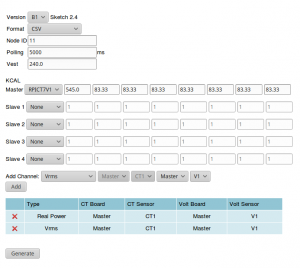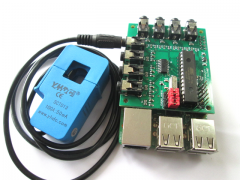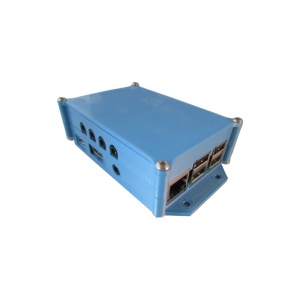RPICT8 Version 5
RPICT8

This page is for board specific information. More information can be found on the generic page for RPICT series.
- 8 AC current sensors.
- Compute real power.
- Fit on Raspberrypi 4 holes mounting pattern.
- AtMega328 Mcu (Arduino UNO)
- MCP3208 12bit ADC
- Stackable with RPICT8 Slave
Compatibility
| Version | Compatible? |
|---|---|
| Raspberrypi 1 A | No |
| Raspberrypi 1 B+ | Yes |
| Raspberrypi 2 B | Yes |
| Raspberrypi 3 B | Yes |
| Raspberrypi 3 B+ | Yes RPICT8 v3.0 (Version RPICT8 v1.3 see this link). |
| Raspberrypi 4 B | Yes |
- Asus Tinkerboard has been reported to work with RPICT units. Note we wont be able to provide support for the Tinkerboard.
Recommended sensors
AC Current sensor
- SCT-013-000
- SCT-006
- SCT-019
Only current output CT are supported.
Stacking Configuration
General stacking information is described in the RPICT stacking page. RPICT_Stacking Version 5
Software Configuration
Using a serial line terminal program one can configure the following:
- Polling interval - Output format (csv or emoncms) - Calibration values (Voltage and Current) - Voltage/current combinations for real power computation. - Output channels
The documentation for serial configuration can be found on this page.
Over Serial Configuration - Sketch 2.2
Over Serial Configuration - Sketch 2.3
Over Serial Configuration - Sketch 2.4
Over Serial Configuration - Sketch 2.5
Over Serial Configuration - Sketch 2.6 & 2.7.1
Over Serial Configuration - Sketch 2.8
Over Serial Configuration - Sketch 3.0
 The board can be configured with the online configurator.
The board can be configured with the online configurator.

Files
Default Sketch
(note boards are sold already flashed with latest stable sketch).
noOSC Sketch
The Default sketch allows up to 28 computation nodes to be run. If more are needed for higher stacks then we recommend to use the noOSC sketch. This is the same as the default sketch but Over Serial Configuration (OSC) as been removed to allow up to 40 nodes to be computed. Configuration has to be edited in the sketch.
noOSC Sketch v1.0
noOSC Sketch v1.1
Default Data Output
Using the manufacture firmware the data output is:
NodeID P1 P2 P3 P4 P4 P5 P6 P7 P8
P1 being the estimated Power using CT1. `Estimated Power` computes power multiplying Irms by Vest. Where Vest is the estimated Voltage setup in the config. By default Vest=240V we recommend to change this to 220V or 110V if your local voltage supply differ.
Other output type can be streamed out. This should be configured in the unit.
All outputs type available are
- Estimated Power (W)
- Irms (mA)
If stacked with another unit that include a voltage port the following outputs can also be added:
- Real Power (W)
- Apparent Power (W)
- Power Factor
- Vrms (V)
Emoncms Config (Emonhub)
Make you read this first.
For default configuration.
[[11]]
nodename = RPICT8
hardware = RPICT8
[[[rx]]]
names = Power1, Power2, Power3, Power4, Power5, Power6, Power7, Power8
datacode = 0
scales = 1,1,1,1,1,1,1,1
units = W,W,W,W,W,W,W,W
Python demo script
First of all make sure you have python-serial package installed
$ sudo apt-get install python-serial
Then copy the following into an executable file and run it.
#!/usr/bin/python2
import serial
ser = serial.Serial('/dev/ttyAMA0', 38400)
try:
while 1:
# Read one line from the serial buffer
line = ser.readline()
# Remove the trailing carriage return line feed
line = line[:-2]
# Create an array of the data
Z = line.split(' ')
# Print it nicely
print ("----------")
for i in range(len(Z)):
if i==0:
print ("NodeID: %s" % Z[0])
else:
print ("Power %d: %s W" % (i, Z[i]))
except KeyboardInterrupt:
ser.close()
Enclosure
Enclosures kit are available as a 3D printed product. Link to the shop.
Both Raspberrypi 3 and 4 format are available.

